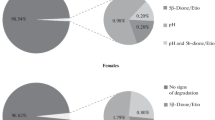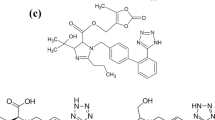Abstract
The application of the design of experiments to optimize method development in the field of forensic toxicology using the urinary morphine 3-glucuronide acid hydrolysis as an example is described. Morphine and its trideuterated analogue (used as an internal standard) were extracted from urine samples by liquid–liquid extraction (ToxiTubes® A) and derivatized by silylation. Chromatographic analysis was done by gas chromatography–mass spectrometry in the selected ion monitoring mode. Using the peak area ratio (morphine-to-internal standard) as the response, we investigated the independent variables that could influence the acid hydrolysis, including temperature (range 70–130 °C), acid volume (range 500–1,000 µL) and time (range 15–90 min). A 23 full factorial design for the screening and a response surface methodology, including a central composite design for optimization, were applied. The factors which influenced the response to a greater extent were temperature and its interaction both with time and acid volume. By application of a multiple regression analysis to the experimental data, a second-order polynomial equation was obtained. The optimal predicted conditions for morphine 3-glucuronide acid hydrolysis were 115 °C, 38 min and 500 µL for temperature, time and acid volume, respectively. Using design of experiments, instead of the one factor at a time approach, we achieved the optimum combination of all factor values, and this allowed the best results to be obtained, simultaneously optimizing resources. In addition, time and money can be saved, since other approaches are in general more time-consuming and laborious, and do not take into account the interactions between factors.


Similar content being viewed by others
References
Miller J, Miller J (2000) In: Statistics and chemometrics for analytical chemistry, 4th edn. Pearson Education/Prentice-Hall, Harrow, pp 182–213
Bezerra MA, Santelli RE, Oliveira EP, Villar LS, Escaleira LA (2008) Talanta 76:965–977
Duarte A, Capelo S (2006) J Liq Chromatogr Relat Technol 29:1143–1176
Ferreira SL, Bruns RE, da Silva EG, Dos Santos WN, Quintella CM, David JM, de Andrade JB, Breitkreitz MC, Jardim IC, Neto BB (2007) J Chromatogr A 1158:2–14
Hajeb P, Jinap S (2009) Food Addit Contam Part A Chem Anal Control Expo Risk Assess 26:1354–1361
Myers RH, Montgomery DC, Vining GG, Borror CM, Kowalski SM (2004) J Qual Technol 36:53–77
Fezei R, Hammi H, M’nif A (2008) J Chemom 22:122–129
Muteki K, MacGregor JF (2007) J Chemom 21:496–505
Måge I, Næs T (2007) J Chemom 21:440–450
Swalley SE, Fulghum JR, Chambers SP (2006) Anal Biochem 351:122–127
Fernández P, Lago M, Lorenzo RA, Carro AM, Bermejo AM, Tabernero MJ (2009) J Chromatogr B 877:1743–1750
Ferrari LA, Triszcz JM, Giannuzzi L (2006) Forensic Sci Int 161:144–150
Kristoffersen L, Bugge A, Lundanes E, Slørdal L (1999) J Chromatogr B Biomed Sci Appl 734:229–246
Lewis RJ, Johnson RD, Hattrup RA (2005) J Chromatogr B 822:137–145
Kraemer T, Paul LD (2007) Anal Bioanal Chem 388:1415–1435
Baselt RC (2002) In: Disposition of toxic drugs and chemicals in man, 6th edn. Biomedical Publications, Foster City, pp 720–724
Christrup LL (1997) Acta Anaesthesiol Scand 41:116–122
Hackett LP, Dusci LJ, Ilett KF, Chiswell GM (2002) Ther Drug Monit 24:652–657
Wang P, Stone JA, Chen KH, Gross SF, Haller CA, Wu AH (2006) J Anal Toxicol 30:570–575
Romberg RW, Lee L (1995) J Anal Toxicol 19:157–162
Duer WC, McFarland S (2007) J Anal Toxicol 31:419–420
Combie J, Blake JW, Nugent TE, Tobin T (1982) Clin Chem 28:83–86
Lin Z, Lafolie P, Beck O (1994) J Anal Toxicol 18:129–133
Bertholf RL, Sapp LM, Pittman DL (1991) Clin Chem 37:759–760
Zezulak M, Snyder JJ, Needleman SB (1993) J Forensic Sci 38:1275–1285
O'Neal CL, Poklis A (1998) J Anal Toxicol 22:487–492
Foltz RL, Fentiman AF, Foltz RB (1980) In: GC/MS assays for abused drugs in body fluids. National Institute on Drug Abuse, Rockville, pp 110–127. http://www.drugabuse.gov/pdf/monographs/download32.html. Accessed 25 Apr 2009
World Anti-Doping Agency (2005). Identification criteria for qualitative assays incorporating chromatography and mass spectrometry. Technical document TD2003IDCR. http:// www.wada-ama.org/rtecontent/document/ criteria_1_2.pdf. Accessed 8 Jan 2006
Myers RM, Montgomery DC, Anderson-Cook CM (2009) Response surface methodology: process and product optimization using designed experiments, 3rd edn. Wiley, Hoboken
Decaestecker TN, Lambert WE, Van Peteghem CH, Deforce D, Van Bocxlaer JF (2004) J Chromatogr A 1056:57–65
Christensen HC, Coombes-Betz KM, Stein MS (2007) In: The certified quality process analyst handbook. Quality, Milwaukee, pp 220–228
Sheehy P, Navarro D, Silvers R, Keyes V, Dixon D, Picard D (eds) (2002) In: The black belt memory jogger: a pocket guide for six sigma success. GOAL/QPC and Six Sigma Academy, Salem, pp 185–210
Crockett DK, Frank EL, Roberts WL (2002) Clin Chem 48:332–337
Author information
Authors and Affiliations
Corresponding author
Rights and permissions
About this article
Cite this article
Costa, S., Barroso, M., Castañera, A. et al. Design of experiments, a powerful tool for method development in forensic toxicology: application to the optimization of urinary morphine 3-glucuronide acid hydrolysis. Anal Bioanal Chem 396, 2533–2542 (2010). https://doi.org/10.1007/s00216-009-3447-8
Received:
Revised:
Accepted:
Published:
Issue Date:
DOI: https://doi.org/10.1007/s00216-009-3447-8




